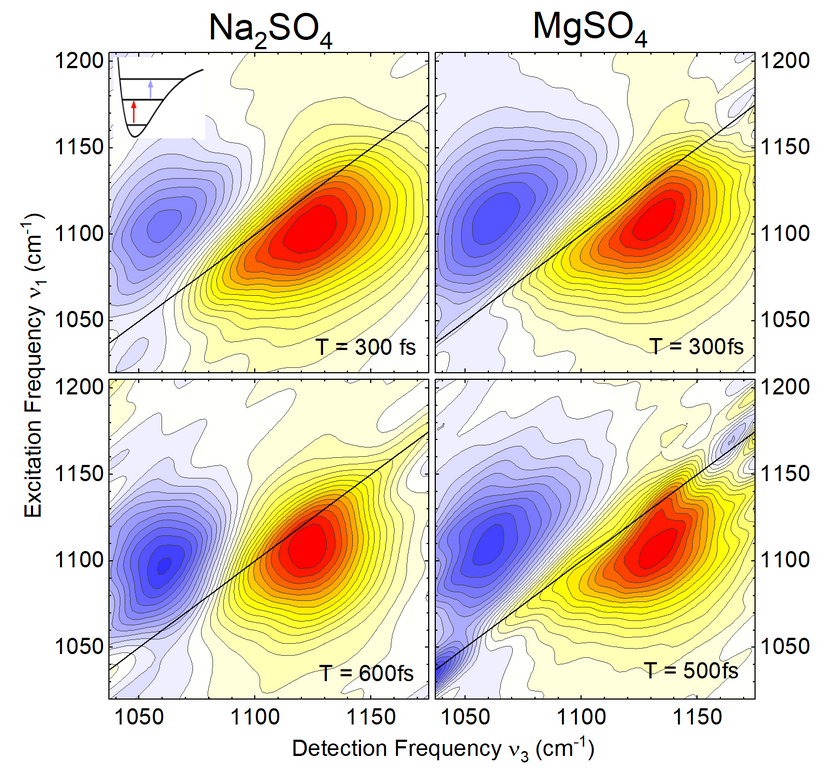The existence of ions impacts water dynamics and structure on many time scales and lengths. New findings from theoretical examinations and ultrafast spectroscopy disclose that the water environment of particular pairs of sulfate and magnesium ions has a key effect on the dynamics of the aqueous solutions.

Two-dimensional infrared spectra of the asymmetric stretching vibration of the SO42- ion for sodium sulfate (Na2SO4, left column) and magnesium sulfate (MgSO4, right column) in water. The strength of the vibrational excitation is plotted as a function of the excitation frequency ν1 and the detection frequency ν3. Yellow-red contours correspond to excitations of the fundamental vibrational transition between the v=0 and 1 states of the vibration (red arrow in the inset image at top left), while blue contours are due to overtone excitations (v=1 to 2, blue arrow). For sodium sulfate, a change in the red-yellow contour from an elliptical line shape (top left) to a more round shape (bottom left) is observed within about 300 fs. This is due to rapidly fluctuating forces exerted on the sulfate ion by the water environment. In contrast, for magnesium sulfate (right column) the elliptical line shape is preserved on this time scale. Here, fast fluctuations are largely suppressed by the presence of magnesium ions in the immediate vicinity of the sulfate ion. Image credits: Max Born Institute
Liquid water, the native medium for cellular and biochemical processes, comprises an intricate network of polar molecules linked by hydrogen bonds. Water reacts to the existence of a solute by altering its local structure. The impact of positively and negatively charged ions on liquid water is generally categorized through the Hofmeister series, which ranks ions depending on their capacity to structure the water surrounding them or disturb the water structure.
Despite several years of research, the molecular mechanisms and microscopic origin of the Hoffmeister series are controversial. The Hoffmeister series, however, has great relevance as it defines the impact ions apply on biomolecules dissolved in water.
New simulations and experiments have now shown ions' considerably more intricate impact on water molecules' dynamics. The study was published in the journal ACS Physical Chemistry Au, and it integrates spectroscopic experiments with thorough theoretical examinations of molecular dynamics and interactions.
Scientists from the Max Born Institute in Berlin, Freie Universität Berlin, and the Ludwig-Maximilian-University in Munich employed the sulfate (SO42-) ions’ asymmetric stretching vibrations as locally sensitive probes to sketch the dynamic properties of the surrounding. In this scenario, hydrated sulfate ions are a prototypical model system, because they are generally identified in minerals and are of great significance in biochemistry and physiology.
To gain knowledge about the local hydration environment, the scientists utilized the experimental method of two-dimensional infrared spectroscopy in the femtosecond time domain and associated the characteristics of sulfate ions in the existence of magnesium (Mg2+) or sodium (Na+) ions at low ion concentrations (see Figure). They discovered that the presence of Mg2+ ions decreases the ultrafast fluctuations of the water shell near a sulfate ion, resulting in a particular slowdown in the solvation dynamics of hydrated MgSO4 compared to aqueous Na2SO4 solutions.
Broad simulations offer a microscopic view of the witnessed dynamics and disclose a molecular picture where the slowdown of the water dynamics emerges from structural characteristics of SO42- - Mg2+ ion pairs that share water molecules in their hydration shells.
Unlike the extensive account in the literature, the explained impacts are of short range and restricted to the first one to two water layers surrounding the sulfate ion. Contrary to the Hoffmeister series, which categorizes the impact of ion types on the water structure, the recent findings establish the specific applicability of individual solvation geometries of particular ion pairs for the dynamics of dilute aqueous systems.
Journal Reference
Kundu, A., et al. (2022) Short-Range Cooperative Slow-down of Water Solvation Dynamics Around SO42−−Mg2+ Ion Pairs. ACS Physical Chemistry Au. ACS Physical Chemistry Au. doi.org/10.1021/acsphyschemau.2c00034.